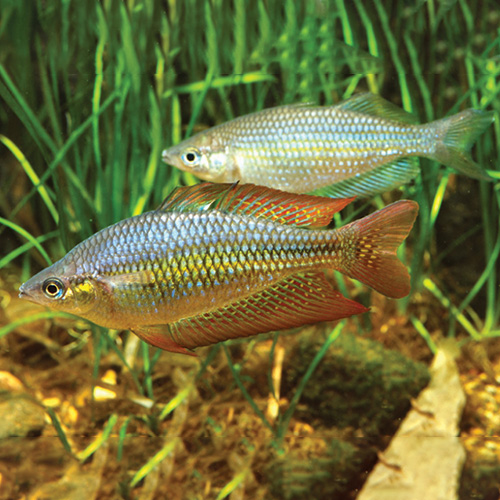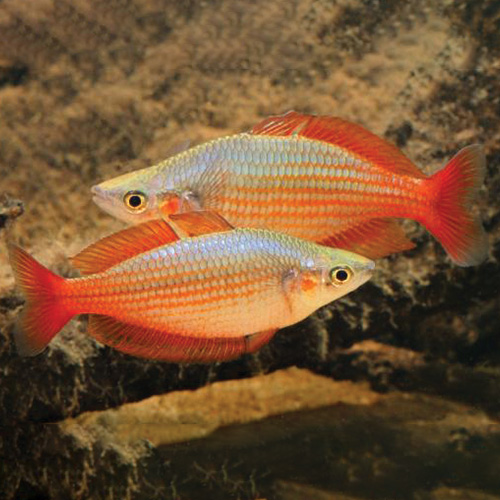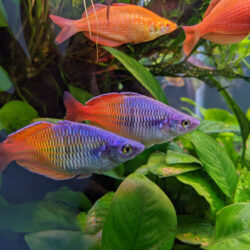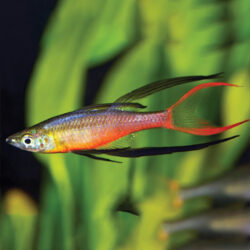Deepwater Creek Rainbow Fish
82 in stock (can be backordered)
Original price was: $13.00.$9.99Current price is: $9.99.
The Deepwater Creek Rainbow Fish have a unique body colouration that is overall pale bluish-green with a slight yellow fading to a white on the lower sides.
According to Wikipedia “The chequered rainbowfish is found in northern Australia from the Mary River east to the Cape York Peninsula and south to the Jardine River, it is also found on some of the Torres Strait Islands. The eastern rainbowfish occurs in rivers east of the Great Dividing Range from the Torres Strait Islands and the Cape York Peninsula south to the Dawson River in Queensland. the desert rainbowfish is endemic to the drainage basin of Lake Eyre.
Rainbowfish Angfaqld has a detailed description as follows;
Species Summary
Melanotaenia splendida subsp. splendida were originally collected from the Fitzroy River in central Queensland and scientifically described as Nemacentrus splendida in 1866. Gerald Allen’s revision of the family Melanotaeniidae in 1980 places them under their current name. The different subspecies of Melanotaenia splendida are not easily identified in relation to each other as they display a great variation of colours and markings. Principal visual differences are body depth and colour pattern, which is variable depending on location and natural environment. At the same time, body form within each subspecies is variably and appears to be related to habitat conditions, which can sometimes make correct identification difficult. Populations of almost every river system they occupy have their own distinctive body colour and pattern. Geographic distribution is very helpful; if you know where they were collected you can generally make a confident identification. Consequently, specific names usually based on the locality where each is found are used by rainbowfish enthusiasts to identify each variety. Where populations need to be identified, they are often done by inclusion of a form or population identifier in brackets following the species name e.g., Melanotaenia splendida subsp. splendida (Burdekin River).
M. s. splendida display a great natural assortment of colours. The basic body colouration is overall pale bluish-green, olivaceous to yellowish, grading to white on the lower sides. Each horizontal scale row is separated by a narrow orange to reddish stripe. The scales on the side of the body usually have a bluish-green, yellowish-red or purplish sheen. The mid-lateral stripe can be faded black to deep yellowish anteriorly, and bluish-green or brownish-green on the caudal peduncle. Other body stripes can be yellow, green, blue or red. There is usually an orange or yellow spot on the opercula. The dorsal, caudal and anal fins can be red and yellow chequered or orange-yellow with bright red spots on their membranes, with faint black edges. Other forms can have a blue-green body with yellow-green fins, with dark flecks and a dark border. However, colour is extremely variable and will depend upon the mood of the fish, water conditions and diet. Females and juveniles have plain silvery bodies and fins that are either translucent or only faintly coloured compared to the brighter colours of males.
Genetic studies beginning in the mid 1990’s (Zhu et al. 1994) revealed the existence of significant genetic variation between populations of M. s. splendida that occur in the upland streams of north Queensland. In particular, these studies highlighted the degree of isolation of upland populations from the lowland populations. Subsequent genetic research (McGuigan et al. 2000) suggested that at least some of these species are unusual variants of Melanotaenia splendida – or populations displaying genes that have traits of more than one species. As a direct result of some of this research, the Utchee Creek Rainbowfish (Melanotaenia utcheensis) was described as a new species in 2000, with populations known from Utchee, Fisher, Rankin and Short Creeks in the North and South Johnstone River catchments (McGuigan 2001).
Rainbowfish from upstream sections of the Burdekin River have long been considered to be a distinct species by rainbowfish enthusiasts, and are known in the hobby as the Burdekin Rainbowfish (Running River or “zigzag” form). This form is believed to also be present in other tributaries draining the Paluma Range, notably the Fanning River. There are other informally recognised forms of “splendida” such as the Davies Creek Rainbowfish, Kuranda Reds and Mena Creek Rainbowfish. Despite the research that has been undertaken to date, the specific status and distribution of M. s. splendida still remains unclear.
Only logged in customers who have purchased this product may leave a review.







Reviews
There are no reviews yet.